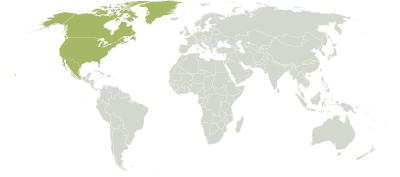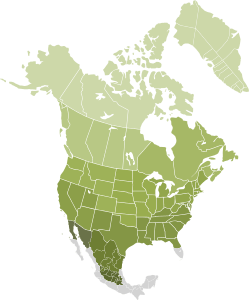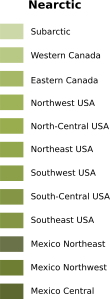Nearctic realm
The Nearctic is one of the eight biogeographic realms constituting the Earth's land surface.

 |  |
The Nearctic realm covers most of North America, including Greenland, Central Florida, and the highlands of Mexico. The parts of North America that are not in the Nearctic realm are Eastern Mexico, Southern Florida, coastal Central Florida, Central America, and the Caribbean islands, which, together with South America, are part of the Neotropical realm.
Major ecological regions
The World Wildlife Fund (WWF) divides the Nearctic into four bioregions, defined as "geographic clusters of ecoregions that may span several habitat types, but have strong biogeographic affinities, particularly at taxonomic levels higher than the species level (genus, family)."
Canadian Shield
The Canadian Shield bioregion extends across the northern portion of the continent, from the Aleutian Islands to Newfoundland. It includes the Nearctic's Arctic Tundra and Boreal forest ecoregions.
In terms of floristic provinces, it is represented by part of the Canadian Province of the Circumboreal Region.
Eastern North America
The Eastern North America bioregion includes the temperate broadleaf and mixed forests of the Eastern United States and southeastern Canada, the Great Plains temperate grasslands of the Central United States and south-central Canada, the temperate coniferous forests of the Southeastern United States, including Central Florida. In terms of floristic provinces, it is represented by the North American Atlantic Region and part of the Canadian Province of the Circumboreal Region.
Western North America
The Western North America bioregion includes the temperate coniferous forests of the coastal and mountain regions of southern Alaska, western Canada, and the Western United States from the Pacific Coast and Northern California to the Rocky Mountains (known as the Cascadian bioregion), as well as the cold-winter intermountain deserts and xeric shrublands and temperate grasslands and shrublands of the Western United States.
In terms of floristic provinces, it is represented by the Rocky Mountain region.
Northern Mexico and Southwestern North America
The Northern Mexico bioregion includes the mild-winter to cold-winter deserts and xeric shrublands of northern Mexico, Southern California, and the Southwestern United States, including the Chihuahuan, Sonoran, and Mojave Deserts. The Mediterranean climate ecoregions of the Southern and Central Coast of California include the California chaparral and woodlands, California coastal sage and chaparral, California interior chaparral and woodlands, and California montane chaparral and woodlands.
The bioregion also includes the warm temperate and subtropical pine and pine-oak forests, including the Arizona Mountains forests and the Sierra Madre Occidental, Sierra Madre Oriental, and Sierra Juarez and San Pedro Martir pine-oak forests.
In terms of floristic provinces, it is represented by the Madrean Region.
History
Although North America and South America are presently joined by the Isthmus of Panama, these continents were separated for about 180 million years, and evolved very different plant and animal lineages. When the ancient supercontinent of Pangaea split into two about 180 million years ago, North America remained joined to Eurasia as part of the supercontinent of Laurasia, while South America was part of the supercontinent of Gondwana. North America later split from Eurasia. North America has been joined by land bridges to both Asia and South America since then, which allowed an exchange of plant and animal species between the continents, the Great American Interchange.
A former land bridge across the Bering Strait between Asia and North America allowed many plants and animals to move between these continents, and the Nearctic realm shares many plants and animals with the Palearctic. The two realms are sometimes included in a single Holarctic realm.
Many large animals, or megafauna, including horses, camels, mammoths, mastodonts, ground sloths, sabre-tooth cats (Smilodon), the giant short-faced bear (Arctodus simus), and the cheetah, became extinct in North America at the end of the Pleistocene epoch (ice ages), at the same time the first evidence of humans appeared, in what is called the Holocene extinction event. Previously, the megafaunal extinctions were believed to have been caused by the changing climate, but many scientists now believe, while the climate change contributed to these extinctions, the primary cause was hunting by newly arrived humans or, in the case of some large predators, extinction resulting from prey becoming scarce. The American bison (Bison bison), brown bear or grizzly bear (Ursus arctos), moose or Eurasian elk (Alces alces), and elk or wapiti (Cervus canadensis) entered North America around the same time as the first humans, and expanded rapidly, filling ecological niches left empty by the newly extinct North American megafauna.
Flora and fauna
Flora and fauna that originated in the Nearctic
Animals originally unique to the Nearctic include:
- Family Canidae, dogs, wolves, foxes, and coyotes
- Family Camelidae, camels and their South American relatives including the llama. now extinct in the Nearctic
- Family Equidae, horses, donkeys and their relatives. now only found in the Nearctic as feral horses
- Family Tapiridae, tapirs now extinct in the Nearctic
- Family Antilocapridae, last survivor of which is the pronghorn
- Subfamily Tremarctinae, or short-faced, bears, including the giant short-faced bear (Arctodus simius) One other member of the group is the spectacled bear (Tremarctos ornatus) of South America. now extinct in the Nearctic
- The American cheetah (Miracinonyx) now extinct worldwide
Flora and fauna endemic to the Nearctic
One bird family, the wrentits (Timaliinae), is endemic to the Nearctic region. The Holarctic has four endemic families: divers (Gaviidae), grouse (Tetraoninae), auks (Alcidae), and the waxwings (Bombycillidae). The scarab beetle families Pleocomidae and Diphyllostomatidae (Coleoptera) are also endemic to the Nearctic. The fly species Cynomya cadaverina is also found in high numbers in this area.
Plants families endemic or nearly endemic to the Nearctic include the Crossosomataceae, Simmondsiaceae, and Limnanthaceae.
Nearctic terrestrial ecoregions
| Sonoran-Sinaloan transition subtropical dry forest | Mexico |
| Bermuda subtropical conifer forests | Bermuda |
| Sierra Madre Occidental pine-oak forests | Mexico, United States |
| Sierra Madre Oriental pine-oak forests | Mexico, United States |
| Allegheny Highlands forests | United States |
| Appalachian mixed mesophytic forests | United States |
| Appalachian-Blue Ridge forests | United States |
| California mixed evergreen forest | United States |
| Central U.S. hardwood forests | United States |
| East Central Texas forests | United States |
| Eastern forest-boreal transition | Canada, United States |
| Eastern Great Lakes lowland forests | Canada, United States |
| Gulf of St. Lawrence lowland forests | Canada |
| Lac Saint-Jean and Saguenay valley forests | Canada |
| Middle Atlantic coastal forests | Southeastern United States |
| Mississippi lowland forests | United States |
| New England-Acadian forests | Canada, United States |
| Northeastern coastal forests | United States |
| Ozark Mountain forests | United States |
| Southeastern mixed forests | United States |
| Southeastern subtropical evergreen forests | United States |
| Southern Great Lakes forests | Canada, United States |
| Upper Midwest forest-savanna transition | United States |
| Western Great Lakes forests | Canada, United States |
| Willamette Valley forests | United States |
| Nearctic temperate coniferous forests | |
|---|---|
| Alberta Mountain forests | Canada |
| Alberta-British Columbia foothills forests | Canada |
| Arizona Mountains forests | United States |
| Atlantic coastal pine barrens | United States |
| Blue Mountains forests | United States |
| British Columbia mainland coastal forests | Canada, United States |
| Cascade Mountains leeward forests | Canada, United States |
| Central and Southern Cascades forests | United States |
| Central British Columbia Mountain forests | Canada |
| Central Pacific coastal forests | Canada, United States |
| Colorado Rockies forests | United States |
| Eastern Cascades forests | Canada, United States |
| Fraser Plateau and Basin complex | Canada |
| Florida Scrub | United States |
| Great Basin montane forests | United States |
| Klamath-Siskiyou forests | United States |
| Middle Atlantic coastal forests | United States |
| North Central Rockies forests | Canada, United States |
| Northern California coastal forests | United States |
| Northern Pacific coastal forests | Canada, United States |
| Northern transitional alpine forests | Canada |
| Okanagan dry forests | Canada, United States |
| Piney Woods forests | United States |
| Puget lowland forests | Canada, United States |
| Haida Gwaii | Canada |
| Sierra Nevada forests | United States |
| South Central Rockies forests | United States |
| Southeastern conifer forests | United States |
| Wasatch and Uinta montane forests | United States |
| Alaska Peninsula montane taiga | United States |
| Central Canadian Shield forests | Canada |
| Cook Inlet taiga | United States |
| Copper Plateau taiga | United States |
| Eastern Canadian forests | Canada |
| Eastern Canadian Shield taiga | Canada |
| Interior Alaska-Yukon lowland taiga | Canada, United States |
| Mid-Continental Canadian forests | Canada |
| Midwestern Canadian Shield forests | Canada |
| Muskwa-Slave Lake forests | Canada |
| Newfoundland Highland forests | Canada |
| Northern Canadian Shield taiga | Canada |
| Northern Cordillera forests | Canada |
| Northwest Territories taiga | Canada |
| South Avalon-Burin oceanic barrens | Canada |
| Northern Lake Superior taiga | United States, Canada |
| Southern Hudson Bay taiga | Canada |
| Yukon Interior dry forests | Canada |
| Western Gulf coastal grasslands | Mexico, United States |
| California Central Valley grasslands | United States |
| Canadian aspen forests and parklands | Canada, United States |
| Central and Southern mixed grasslands | United States |
| Central forest-grasslands transition | United States |
| Central tall grasslands | United States |
| Columbia Plateau | United States |
| Edwards Plateau savanna | United States |
| Flint Hills tall grasslands | United States |
| Montana valley and foothill grasslands | United States |
| Nebraska Sand Hills mixed grasslands | United States |
| Northern mixed grasslands | Canada, United States |
| Northern short grasslands | Canada, United States |
| Northern tall grasslands | Canada, United States |
| Palouse grasslands | United States |
| Texas blackland prairies | United States |
| Western short grasslands | United States |
| Alaska-St. Elias Range tundra | Canada, United States |
| Aleutian Islands tundra | United States |
| Arctic coastal tundra | Canada, United States |
| Arctic foothills tundra | Canada, United States |
| Baffin coastal tundra | Canada |
| Beringia lowland tundra | United States |
| Beringia upland tundra | United States |
| Brooks-British Range tundra | Canada, United States |
| Davis Highlands tundra | Canada |
| High Arctic tundra | Canada |
| Interior Yukon-Alaska alpine tundra | Canada, United States |
| Kalaallit Nunaat high arctic tundra | Greenland |
| Kalaallit Nunaat low arctic tundra | Greenland |
| Low Arctic tundra | Canada |
| Middle Arctic tundra | Canada |
| Ogilvie-MacKenzie alpine tundra | Canada, United States |
| Pacific Coastal Mountain icefields and tundra | Canada, United States |
| Torngat Mountain tundra | Canada |
| California coastal sage and chaparral | Mexico, United States |
| California interior chaparral and woodlands | United States |
| California montane chaparral and woodlands | United States |
| Baja California desert | Mexico |
| Central Mexican matorral | Mexico |
| Chihuahuan desert | Mexico, United States |
| Colorado Plateau shrublands | United States |
| Great Basin shrub steppe | United States |
| Gulf of California xeric scrub | Mexico |
| Meseta Central matorral | Mexico |
| Mojave desert | United States |
| Okanagan (South) shrub steppe | Canada |
| Snake–Columbia shrub steppe | United States |
| Sonoran desert | Mexico, United States |
| Tamaulipan matorral | Mexico, |
| Tamaulipan mezquital | Mexico, United States |
| Wyoming Basin shrub steppe | United States |
References
- Abell, R.A. et al. (2000). Freshwater Ecoregions of North America: A Conservation Assessment Washington, DC: Island Press, .
- Flannery, Tim (2001). The Eternal Frontier: an Ecological History of North America and its Peoples. Grove Press, New York.
- Ricketts, Taylor H., Eric Dinerstein, David M. Olson, Colby J. Loucks, et al. (1999). Terrestrial Ecoregions of North America: a Conservation Assessment. Island Press, Washington DC., .
External links
| Wikimedia Commons has media related to Nearctic. |

- Map of the ecozones
- Nearctica, The Natural World of North America
- . New International Encyclopedia. 1905.